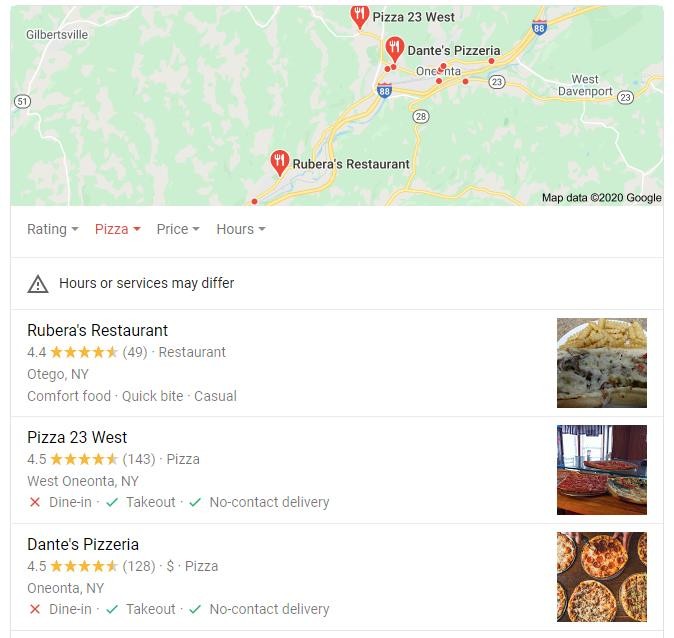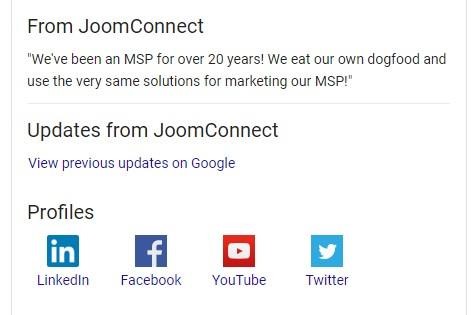JoomConnect Blog
How To Have Your MSP Turn Up In a Local Search
When it comes to search results, all search is local. The more connected you are to your community, the better your chances are to rank higher in local search results. While there are a variety of steps to increase your local search marketing, the most basic, but critically important, is to ensure that Google knows where your business is. If your NAP (Name, Address, Phone Number) isn’t consistent throughout your presence on the internet, there is a chance that you may not appear in your localized search results.
What is the Local Search Result?
Privacy issues aside, Google (yes, there are other search engines, but they pale to the market share Google has) knows where you are located. According to Google, 46 percent of searches have a local intent, this means when a person searches for “pizza restaurants”, Google assumes that the searcher means, ‘near me’ and will provide the searcher with a list of local pizzerias. This listing is known as the Local 3-Pack.
What is the Local 3-Pack?
The Local 3-Pack is the block of three business listings that appear below the map in the result page after a localized search.
User intent is a critical component of how and why Google decides on which businesses to place in the Local 3-Pack. Google tends to focus on immediate purchase intent, which is why if you search for ‘Pizza parlor’, Google assumes you want to purchase a pizza (locally) now and the Local 3-Pack is triggered. However, searching for a purchase or service that is not recognized as an immediate need or a generic term such as ‘cloud computing’, may result in your search not delivering a Local 3-Pack result.
Due to the nature of managed services, few customers are going to make an immediate purchase. Many an MSP can attest to this; closing the deal can take months, even years after the initial contact. Google also sees that, based on traffic and browsing habits, many IT-related terms are typically used to research and understand a topic and not necessarily lead to a business selling something. In a way this makes sense, how many calls has your MSP received from potential customers who were ready to make a purchase then and there? The initial contact is more often than not one for more information and that is what Google offers as a search result.
A good example (and keep in mind, this changes based on your location) would be looking up terms like “tech support” and “it services.” This, for the most part, pulls in a Local 3-Pack. Searching for “cybersecurity” doesn’t.
In order to trigger the Local 3-Pack for Directive, we had to make our intention to make a purchase more definitive by making the search criteria more specific: managed service providers near me. If we had just used the term, “managed service provider”, the results would have been blogs or a featured snippet describing what a managed service provider does.
Make no mistake, there is nothing wrong with your blog or a featured snippet being a page one result on Google. However when trying to increase your presence locally, you want your business to be the result of a local search, because that is where the majority of your customers are going to be coming from and the Local 3-Pack is where you should strive to be.
Where Does the Information in the Local 3-Pack Come From?
Google pulls the information which goes into the Local 3-Pack about your business from your Google My Business (GMB) account, not your website. Google My Business is a service to put your business profile and information where Google can easily access it and provide it to searchers. This is why it is critical that information on your GMB account be as accurate as possible. In fact, one of the first things you need to do as an MSP (or any business) to increase your chance to be listed on the Local 3-Pack is to claim your Google My Business page (and Bing Places too). The most important information your GMB account must have is your business’ name, address, and phone number, also known as NAP.
Google My Business and NAP
Google My Business is an essential part  of your local SEO for your MSP, and this information is used to populate a variety of other local search tools: Local 3-Pack, Google Maps, and the Knowledge Panel.
of your local SEO for your MSP, and this information is used to populate a variety of other local search tools: Local 3-Pack, Google Maps, and the Knowledge Panel.
Moreover, your GMB profile can include a host of information about your business. Information such as services you offer, contact details, business description, opening times, even posts about events and promotions you're having. You can even link to specific blogs, add photos, and any content which can better help define your business. Finally, GMB allows you to add social proof to your results, such as Q&As, and reviews about your services.
While Google My Business is one of the most influential places your NAP can appear, it is not the only place. In fact, the more places your business appears, the stronger your business’ authority becomes. Another term for NAP is citation, a citation is any place your business’ NAP or NAP(W) (name, address, phone number, and website URL) appears online. Typically the NAP(W) of your MSP will appear in an online business listing or directory, such as the Yellow Pages online, or Yelp. Additional places for your NAP(W) to appear would be your social media accounts, such as Facebook.
Now’s the time to take a moment to check your NAP(W) using the free listing checker of your choice.
The takeaway when it comes to NAP(W) is that wherever your business appears online, whether a business listing, your website, your social media, or your Chamber of Commerce website, they should all have the same name, address, phone number, and website URL. Consistency is key to local search success.
How To Rank Well For Local Searches
As with all things SEO, local search success requires a two-tier process. The first is technical SEO; the basics of SEO. In addition to ensuring your NAP(W) is consistent, some of these basics include:
The second SEO tier should focus on content and give local visitors a reason to believe that as a member of the community, you know their needs and are the best local MSP to address them. Steps you should take to increase your local presence include:
Encouraging testimonials and reviews from local clients: As we noted earlier, social proof is critical to giving potential customers the confidence to take a chance on you. Social proof can come from local businesses and residents, particularly those who are recognized in your community. Testimonials are a valuable tool not only for beefing up your local bonafides, but also for marketing your MSP.
Get involved with local community events: During these trying times, your expertise as an MSP and technology expert can be used to support your fellow businesses as they adapt to the new normal. While face-to-face meetings are still difficult, you can host webinars in conjunction with your chamber. The good will of this act can reward your business in a variety of ways, such as with backlinks and case studies. If you’re still on the fence about the value of local events, here are 10 reasons why your MSP should sponsor a local event.
Develop high-quality backlinks with local businesses: The majority of local businesses have a website, and many have blogs or other content. Ask them if you can write a guest blog or press release on a topic of interest. For example, due to the coronavirus many businesses have increased their security practices to accommodate their remote workers. Your blog could discuss the changes the company made to increase their security, and add a link to the relevant service page on your site.
Highlight your expertise with locally focused case studies: Testimonials and reviews are important because they provide social proof that prior customers are satisfied with your work. The next step after a testimonial is the creation of a case study. Case studies let potential customers know that you are able to perform the tasks they need, based on your prior successes. Case studies can also serve as a deliverable, a means to sweeten the deal when asking for potential clients’ contact information.
Produce content which is relevant to your local audience: Finally, your content needs to include information your local audience will recognize as being important to the location. For example, if there has been a rash of phishing attacks in your area, you could write an informational blog or help your local newspaper construct a press release informing local residents of the issue and how to protect themselves. Once you embrace the concept that content is king and what it means for you as an MSP, you’ll begin to see the results you’ve been looking for.
All Search is Local
While focusing on increasing your ranking should be the primary goal of your SEO, when developing an SEO plan, your MSP should always consider how to better increase your local presence. Your local SEO should supplement the overall marketing strategies designed for your MSP. Your marketing plan needs to ensure you have all the pieces in place to enable your MSP to come up as the result not just on page one, but also on a local search; because all search is local.
If you’re an MSP with multiple locations, we haven’t forgotten about your unique needs. In fact, we have a blog designed to help your MSP rank for multiple locations. Finally, if you are unsure about how best to develop your SEO and marketing strategies, JoomConnect can help. Call 888-546-4384 today to schedule an appointment.




Comments